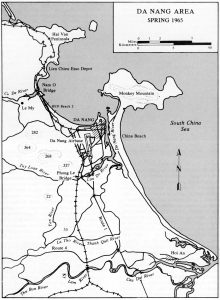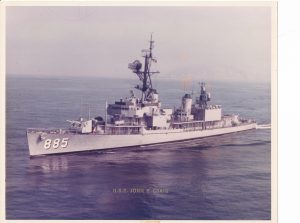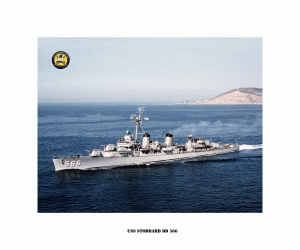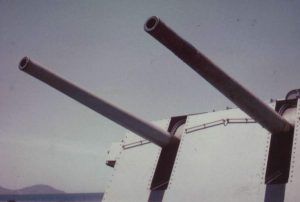A young US Marine Corps corporal directs modern history’s largest Naval bombardment in support of ground forces, wiping out an entire Viet Cong battalion augmented by Red Chinese regular soldiers.* The battle was then covered up, as if it never happened.
28-29 July 1965
Where the hell are you, Charlie? You’re out there. I feel it.
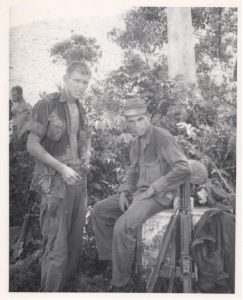
A rawboned, lanky U.S. Marine strained to detect movement in the inky darkness, a starless space made blacker by a rain squall that suppressed the sounds of soldiers creeping toward their objective. A few feet away, a South Vietnamese Ranger, Sergeant Thi, also patrolled, straining to spot a large Viet Cong force they knew was approaching. An attack was imminent.
As he scouted the area, Corporal Karl Lippard mentally took inventory of his dicey situation and limited assets. He was armed with an M14 rifle and four 20-round magazines. Sgt. Thi carried a .30-caliber M1 carbine, and a Colt 1911 semiautomatic pistol was tucked in his M9 shoulder holster. The Marine had stowed his map case, helmet, poncho and pack in an old French bunker near the Ca De River bridge’s north approach. A telephone land line linked the abandoned bunker to roughly 20 other Marines dug-in on the south side. All were “Raiders”, a company of U.S. Marines that had received specialized training—“rubber boat” operations and submarine insertion, for example. Raiders were elite forces, the handpicked best of each U. S. Marine Corps battalion.
As the rain squall intensified, Lippard and Thi returned to the French bunker to retrieve their ponchos. A South Vietnamese army (ARVN) soldier was manning the concrete shelter, talking on a PRC-10 backpack radio…but to Viet Cong troops. Lippard pulled the pin of a grenade and placed a hand on the bunker wall, but before he could take out the VC infiltrator, Sgt. Thi tossed his own grenade. Its blast cut the enemy soldier in half, severed the phone line and drove debris into Lippard’s knee.
“My grenade was live, still in my hand, when I got hit,” Lippard recalled. “Had to replace the pin.” The Marine stepped inside the bunker, confirmed the VC was a goner and checked the PRC-10 radio. It was covered in blood and raw flesh, but still functional.
That radio would become his lifeline.
Positioned on the north side of the Ca De River, which emptied into nearby Bay of DaNang, Lippard was acutely aware that he and his Vietnamese Ranger sidekick were mere tripwires, a flesh-and-blood early warning system. The 19-year-old Marine had orders to sound a warning, if anybody approached the bridge from the north. Nobody—friend or foe—would be permitted to cross.
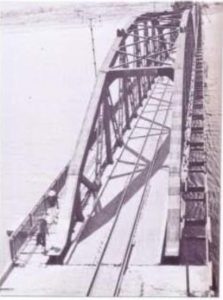
Had the VC mole alerted nearby enemy troops that the bridge was defended by a pitifully small force? No way of knowing, but the grenade blast that had silenced him surely would attract Charlie’s attention to the old bunker.
In fact, Lippard wasn’t “officially” in that bunker on the Ca De River’s north bank. Then-Major General Lewis W. Walt’s Tactical Area of Responsibility ended on the south end of a five-span, quarter-mile steel structure. With a set of railroad tracks down the center and pedestrian walkway along the west side, the bridge was a critical north-south artery. “Highway One” and a railroad converged at that crossing, a gateway to the main route linking “DaNang to places north, such as Phu Bai and Hue,” according to the record of a ship soon to be anchored nearby, in the bay.
Holding that junction was absolutely vital. Regimental commander Colonel Edwin B. Wheeler had told 2nd. Lt. James Reeder, Lippard’s immediate commander, “Lieutenant, if you lose this bridge, you and I are both going to be fired.” But holding it from only the south end was tactically near-impossible.
“There was no room to support Marines on the south side,” Lippard recalls. “The available space [there] could only hold about 20 Marines. Besides, that’s about all that could be spared. We were spread real thin in July 1965.”
To have any serious hope of preventing enemy troops from taking the bridge, a full company of Marines, backed by artillery, should have been firmly entrenched on the north side. But bizarre rules of engagement in mid-1965 placed responsibility for defending that important span’s northerly approach in the hands of a South Vietnamese army battalion located about a half mile farther north, close to the beach. Comprising two understrength platoons, these“Popular Force” troops were a battalion in name only, a reserve unit commanded by a schoolteacher. They were volunteers, designated the Army of the Republic of Vietnam (ARVN) 2nd Regional Force.
A USMC battalion would be composed of 1,000 Marines. In contrast, “a Vietnamese ‘battalion’ would indicate 600 or more men,” Lippard explained. “Years later, we found documents [proving] the ARVN 2nd was only a couple of platoons, mostly farmers. Weekend warriors, often with families in tow. But two platoons of drop-and-run farmers wouldn’t cut it, if hit. That ‘battalion’ would be wiped out.”
Lippard and Thi knew little about Viet Cong movements in the area or the unit set to attack the bridge that night. They had been given no intelligence, even though 3rd Marine headquarters was well aware that the 7th Viet Cong Battalion had slipped between the Bay of DaNang and a ridge of mountains the day before. Two Marine companies had been dispatched to engage that force, but they never encountered the 7th VC. It had already passed through, pushing to the north.
Records indicate that Navy ships positioned offshore had “tried to interdict this battalion, shelling its [potential] positions, as it moved,” Lippard said. A combat action report noted the 7th VC was still on the march 28 July, arriving in a valley a few miles north of the Ca De River bridge late that day.
Well after sunset, two separate formations, each comprising two companies of Viet Cong and Red Chinese regulars, started maneuvering to the south. Their apparent plan was to sweep across the Ca De River bridge, overrun a 3rd Marine Division command post and capture the huge DaNang airbase 4.5 miles west of the city.
“Confirmed,” Lippard asserted. “There were [a total of] 16,516 Viet Cong against 1,140 men of 2nd Battalion, 4th Marines, in open, fixed positions. They’d be overwhelmed, with no support,” if squeezed by enemy troops from the north and south.The enemy would have destroyed innumerable aircraft, including helicopters slated to support a major battle shaping up at Chu Lai, well to the south.
“The Fourth Marines would have been doomed,” Lippard declared. “Another 1,121 Marines—the First of the Fourth—on the beach to the northeast at Ky Ha would have been next. General Walt could see it coming. His [planned] strike at Chu Lai…would be preempted by that VC offensive [launched] at the Ca De River bridge. He had no real protection. No one to come to his aid. Therefore, he sent what he had to the bridge and hoped for the best.”
Conceivably, the 7th VC—about 600 strong—would race down to Chu Lai, attacking from behind and wiping out an assembling American force of some 1,140 men.
The only speed bumps were a Marine and ARVN Ranger holed up near a bunker on the north end of the bridge, backed by 20 lightly armed Marines on the south side. It’s safe to assume that 7th VC commanders fully expected to swat that handful of Marines aside and be in control of DaNang air base before dawn on 29 July.
Clearly, U.S. commanders were anticipating an attack from the northwest by a massive VC force estimated to total 5,574 combatants in the DaNang operations area. On 1 July, Marine Division headquarters had issued an order warning of precisely that possibility. A subsequent missive on 17 July approved naval gunfire support (NGS) for in-country employment, albeit with constraints. Supporting fire had to be “observed and controlled,” called in by only U.S. forces, and independent fire from any ship offshore was banned.
DaNang operations area. Battle of the Ca De River bridge occurred in upper left.
Something big was about to happen, but Lippard had no idea what. Around 2100 (9:00 p.m. local), “we began to receive enemy fire from several directions [near] the bunker, increasing in intensity as I tried to raise somebody on the radio,” he said. Only one faint response was received—a patrol some five miles up-river. It was unable to relay a message.
“A Mayday call went out to any station on the net, “Lippard recounted.“Division headquarters came up, and I quickly gave them positions of attacking forces, while I could.” He noted that the enemy was “Danger close!” No artillery was available, so aircraft were dispatched. Soon, USMC F-4B Phantoms from DaNang air base arrived and made three strikes on coordinates Lippard provided, pounding rear elements of the 7th VC Battalion.
“Division never identified themselves. Never said what, if anything, they were sending,” Lippard said. He was told to identify himself, “but I declined to give my position. Evidently satisfied, they sent everything they had—aircraft and ships.” One U.S. Navy ship steamed for several hours to get on-station. “So division knew they were in trouble. They also knew somebody on the other end of that radio [link] could read a map and was under fire. A heavy firefight was in progress.”
Seasoned enemy soldiers intent on clearing the French bunker and sprinting across the bridge were hardly deterred by three rapid-fire F-4 strikes. The 7th’s troops kept coming, and Lippard and Sgt. Thi kept picking them off, when briefly illuminated by lightning.
In short order, Lippard had shot and killed 15-20 enemy soldiers with his M14. “They were attacking in threes, so we could take them down fairly quickly.” Sgt. Thi ran out of M1 ammunition, prompting Lippard to trade his M14 and extra ammo magazines for Thi’s .45-caliber pistol. The Marine could fire the forty-five one-handed and still operate the PRC-10 radio, his only means of communication.
Fortuitously, Lippard happened to be an expert shot with a forty-five. Years later, he would set world records for nailing targets at 500, 600 and 1,000 yards with the “Combat NCO”, a .45-caliber semiautomatic of his own design.
With enemy fire zeroed-in on the old bunker, Lippard and Thi abandoned it, moved about 75 yards up the beach, and took cover behind sand dunes, backs to the water. Lippard radioed a brief situation report (SITREP) to division headquarters, which merely acknowledged that artillery couldn’t reach him, then went silent.
“No further transmission. None from them or me. I was busy,” Lippard clipped. The young Marine was on his own. Reinforcements and artillery simply weren’t available. He transmitted in the blind, “”Mayday! Mayday! Mayday! Any station this net! This is Hotel Three! Do you copy? Over!”
USS John R. Craig (DD-885)
“Hotel Three, this is Assassin. Give me your coordinates.” Out there in the DaNang Bay, just offshore, a very powerful ally was arriving. Answering Lippard’s call was Harry Rodgers RD2, a sailor aboard the USS John R. Craig (DD-885), a U.S. Navy destroyer sporting four five-inch guns, two on its forward deck and another two on the aft. Rodgers was tasked with maintaining communications between the ship and a “target spotter” ashore. He received and plotted target coordinates as requested by the spotter. Those were passed to the ship Gunnery Officer, who fed them into a fire control computer and fired the guns. The spotter—Lippard, in this case—would call for illumination, high-explosive or white phosphorus rounds and make target adjustments, as required.
Navy gun support tactics in mid-1965 were to “get in as close to shore as possible, drop anchor and maneuver [to] bring guns to bear, while swinging on the anchor chain,” according to the Craig’s history. The ship drew about 18 feet of water and was now anchored in about 25 feet. Crewmembers said the Craig’s propellers were churning up bottom mud to keep the ship broadside to the beach, ensuring both fore and aft five-inch gun mounts could provide supporting fire.
By 2141 (9:41 p.m. local), the Craig was in position, lights out, and starting to fire illumination rounds, directed by Lippard’s radio calls. Now, “I could see the [enemy] force…but was unaware that a whole battalion was engaging,” the Marine recalls. “The Craig came in [and started firing] to the right of the airstrikes, immediately across my front, giving me some relief.”
Once he realized a huge Viet Cong/Red Chinese force was caught in the open, lit up by the Craig’s first illumination rounds, Lippard requested high-explosive shells. “I called the first rounds within 100 yards” of his and Thi’s beach position. “If I had not retired to the beach, I would have died at the bridge. It was very bad on the beach, but the dunes [absorbed] a lot, and as the enemy fell back, concussions from naval gunfire and [incoming] enemy fire decreased.”
Noise from airbursts was deafening, complicating radio communications. As Lippard shot enemy soldiers closing on his position, he transmitted a steady stream of radio calls, directing the big guns’ devastating fire. High explosive rounds “were tight” and accurate. The advantages of heavy rain and pitch darkness that enemy commanders had counted on for concealment were eradicated by frequent illumination rounds turning night into day.
Up the beach, the South Vietnamese reserves “were digging to China, pinned against the sea. [The Craig’s incessant barrage] had them bottled up and afraid to move,” Lippard said. “They had no idea who was calling in the fire or where it was coming from.”
Illumination rounds enabled Lippard and Thi spotting and shooting enemy troops “that made it to within fifteen yards of us. It was close; very, very close,” the Marine distinctly remembers. “The ‘problem’ was danger close that night. I was down to just my pistol, and plotted the last rounds right on my position. [We] could not hold, without maximum firepower on me. We got lucky.”
Lippard was a reluctant student, when assigned to Map and Aerial Photo School in his early Marine Corps days, yet graduated at the top of his class. On the night of 28-29 July 1965, he was grateful for training-honed skills that enabled calling in absolutely devastating fire for almost five hours. The USS Craig ultimately fired 340 five-inch rounds—57 illumination, 22 white phosphorous and 261 high-explosive shells.
At 0146 (1:46 a.m.) on 29 July, the USS Stoddard (DD-566) slipped into DaNang Bay and joined the battle. Lippard was unaware that two ships were firing through the night. He simply called the coordinates and that zone was obliterated. “They answered a Marine corporal’s Mayday. No questions.”
Relentless pounding by two Navy destroyers’ five-inch guns forced the Vietcong and Red Chinese regulars to “collapse on themselves. I followed up the beach as enemy troops [dropped back], then inland as they retraced their approach of march,” Lippard continued. Approaching the ARVN reserves’ position, “Sgt. Thi broke off to identify me on their flank. I moved inland, following the enemy and [directing naval] gunfire. I was then forty-five yards forward of the ARVN position.” The Marine was alone in no-man’s land, surrounded by dead enemy soldiers…or what was left of them. Lippard doesn’t talk about that.
When the Craig and Stoddard ceased firing, “I retired back to the beach and retraced my movements to the point of first call [for naval gunfire]. There I remained until daylight.” The Craig was ordered to weigh anchor and depart around 0310 (3:10 a.m.), but the Stoddard remained in DaNang Bay until about 10:00 a.m. “The battle was over, but she finished some mop-up, [shelling] the base of the mountains [to take out] any stragglers or other units that might arrive.”
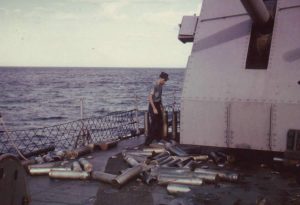
Records of the battle are sketchy and don’t always agree, but Lippard’s research found that 443 shells were fired by the Craig and Stoddard in response to his Mayday calls the night of 28-29 July 1965. Another 33 were delivered, during post-battle mop-up operations. Ship logs have ambiguous accounts, including numbers that don’t match other records: the USS John R. Craig—under the command of Navy Commander James Kenneth Jobe and supported by Lt. Jeremy Michael Boorda, the Weapons Officer—fired 348 rounds, while “conducting a night firing mission.” How many the USS Stoddard delivered under the command of U.S. Navy Commander Charles Presgrove is believed to be 95 rounds in the early morning hours of 29 July, and another 174 in “after-action” operations, according to a Naval War Gunfire Support Record.
A personal log written by Henry Lehtola, an enlisted sailor-turned-historian who chronicled the Craig’s role in the 28-29 July 1965 battle for the Ca De Bridge backs Lippard’s account: “Anchored DaNang. …preparing to open fire. The VC must have been raising hell earlier. You could hear small arms fire on the beach and see tracers flying. Flares and star shells lit up the whole sky.”
The U.S. Marine Corps War Journal’s cursory documentation for 28 July notes, “USS Craig commenced firing on designated targets. 340 five-inch rounds expended—57 illumination; 22 white phosphorous, and 261 high explosive. At 0146 hr., Craig joined by USS Stoddard (DD-566) in support.”
Although exhausted, Corporal Karl Lippard jotted down a few notes about the night’s battle and had his knee wound dressed. Later, he snapped several color photos, then waited, fully expecting a thorough debriefing by his commanders. It didn’t happen. Nobody at headquarters ever asked for Lippard’s account, verbal or written.
Senior Marine commanders definitely knew the intense Ca De River bridge battle had occurred. In fact, the USS Craig and Stoddard destroyers would not have steamed into DaNang Bay in response to Lippard’s Mayday call, unless ordered by the Commanding General of Naval Forces, Maj. Gen. Walt. However, 3rd Marine headquarters apparently never reported the engagement’s stark truth: A single USMC Raider, aided by an ARVN Ranger, directed naval gun fire on a battalion-size unit of enemy soldiers caught in the open. After about five hours of intense bombardment, the Viet Cong 7th Battalion ceased to exist. No enemy soldiers captured. No wounded recovered. No sign that any of the unit’s approximately 600 Viet Cong and Red Chinese combatants had escaped. The 7th VC simply vanished, never to reappear in subsequent reports.
Incredibly, not a single Marine or ARVN soldier was killed. “No Marine or ARVN losses,” Lippard confirmed.
“The end result of this battle was total destruction of the 7th Viet Cong Battalion, by U.S. Marines in defense of the bridge complex,” Lippard recapped. “The Marine Corps acted with speed and force—brought in Marine Air Wing strikes and quickly moved Navy ships into position to provide full gun support within minutes of my call. …This is believed to be one of the finest examples of combined Navy and Marine assets…in support of a small unit, during the Vietnam War.”
Although U.S. commanders may have ignored or forgotten the Ca De River bridge battle, senior South Vietnamese military and political leaders deeply appreciated what Lippard and his fellow Marines had done. Lippard was quickly summoned to an ARVN headquarters and awarded the Vietnamese Cross of Gallantry with Palm insignia, the first of three he earned. Later, Vietnam’s then-Premier, Nguyen Cao Ky, recognized Lippard for his distinguished actions in defending the bridge.
Why top U.S. officers never acknowledged Corporal Lippard’s role in the Ca De River bridge battle and decimation of a large enemy force in late July 1965 remains a glaring unknown. Theories abound, and there are probably bits of truth in each. Marine commanders, at that time, were convinced their communication links had been compromised. Reporting through regular channels that a major headquarters and the vital DaNang airbase came within a whisker of being overrun and wiped out by a Viet Cong force augmented by Communist (dubbed “Red” by Marines) Chinese soldiers might have alerted North Vietnamese interceptors that U.S. and ARVN forces were spread dangerously thin south of the Ca De River. Such knowledge certainly would have emboldened VC commanders to try taking the bridge again. As it was, a few days later, on 5 August, Viet Cong troops managed to blow up fuel tanks containing about 2,000,000 gallons of jet fuel near DaNang.
Or maybe acknowledging that a solitary U.S. Marine was outside the allowed operating area—north of the bridge, in ARVN territory—and calling in U.S. Navy gunfire to wipe out a large enemy force was considered too sensitive for political palates. At the time, South Vietnamese military leaders were suspicious of U.S. intentions and quick to call foul.
Had the 7th VC Battalion broken through and destroyed critical strike aircraft and helicopters on the DaNang air base flightline in late July, a key Marine attack at Chu Lai, planned for mid-August, might have been scrubbed. Nobody in the U.S. chain of command dared admit that the Marine Corps came very close to suffering one of its worst defeats in history, just as that major offensive was in the offing. Especially at a politically sensitive time, when the White House and Pentagon desperately needed a victory to establish U.S. credibility in Vietnam.
Ironically, 614 Viet Cong were killed and nine taken prisoner in the subsequent Chu Lai battle—about the same as North Vietnam lost in one night at the Ca De River bridge. And forty-five Marines were killed and 120 wounded in the week-long battle at Chu Lai. In contrast, none were lost, during a furious, five-hour shootout north of the Ca De River that night of 28-29 July.
For whatever reason, the 18-24 August 1965 battle at Chu Lai is hailed as the U.S.’s “decisive first victory” by historians, while a deadly storm of fire and steel that erased an entire Viet Cong battalion almost one month earlier is never mentioned in official and scholarly accounts of the Vietnam War. At least none have surfaced. Was it buried in official secrecy born of near-miss embarrassment? Or intentionally “overlooked” and conveniently forgotten?
For his extraordinary, central role in holding a crucial river crossing, Lippard never received a blip of public acknowledgment, word of high-rank congratulations or simple “thanks”—let alone a medal—from his own country. Not even a purple heart for a wound received in heavy combat that night.
True to Karl Lippard form, though, he doesn’t really care. Instead, he chooses to emphasize that the Ca De River battle is a testament to the historically effective American military philosophy of training its warriors to improvise on the fly and do what it takes to get the job done. The ferocious fight of 28-29 July 1965 is also a loud-and-clear example of the trust placed in every Marine “Raider”, whose call for artillery, air or naval gunfire support isn’t questioned. Those holding the lightning bolts of American power merely “Roger” and commence firing or dropping on targets the Marine designates.
In Lippard’s four-year tour as an active-duty Marine, he was wounded seven times and finally returned to the states on a gurney. He was offered a field commission to 2nd Lieutenant, but declined. Instead, he was promoted to Sergeant (E-5) and assigned to the drill field, turning fresh recruits into a new generation of Marines. Thanks to right-shoulder wounds, Lippard had the distinction of being the only Marine permitted to salute with his left hand.
He worked in the aerospace, property development and construction sectors for several years, but ultimately established himself as a world-class gunmaker and designer. He holds 20 patents, has another 147 pending, and is a vocal advocate for re-arming America’s military forces and citizens, following decades of incessant assaults that drove most U.S. firearms and ammunition manufacturers out of business.
Today, Karl Lippard is committed to reversing that trend and ensuring the United States can defend itself against all enemies, all the time. His vision covers the spectrum from semiautomatic .45-caliber pistols and unique rifles (his patented designs) to a new class of naval Gunship Destroyers capable of once again supporting troops ashore. He currently holds a $65-billion letter-of-commitment that underwrites a proposal to build and deliver 50 of these cutting-edge gunships for the U.S. Navy.
But that’s another story in the Karl Lippard saga. After seven decades, this seasoned, scarred American warrior is still fighting and winning.
WARRIORS DENIED
After the above was published in 2018, Karl Lippard’s incredible story rapidly circulated among retired Marine and Navy communities via the magic of Internet. Soon, hundreds of Vietnam veterans separated by half a century were networking and reconnecting. Many who had been aboard the two destroyers—USS Craig and USS Stoddard—vividly recalled their response to a Marine Raider’s “Mayday” call and collectively firing more than 400 five-inch rounds to destroy a large enemy force near Da Nang in the summer of 1965.
When Lippard was invited to address a reunion of USS Stoddard sailors in San Pedro, California, critical tidbits of information, ranging from personal tales to vital strategic data, began to surface. For example, Karl later received a call from a veteran, who said, “I was the radarman on the other end of your comm link that night. We thought you’d been killed!” In fact, most of Stoddard’s sailors were unaware that an entire Viet Cong battalion had been decimated by their ship’s and the USS Craig’s sustained shelling.
A subsequent e-mail message from a former Stoddard sailor capsulized sentiments of those attending that September 2018 reunion:
“During my 11 months in Vietnam, many involved in [Naval Gunfire Support], every mission was important. However, a few, including the Ca De River Bridge and the Esso Storage Tank missions, stand out as being more intense and critical. Karl, we were aware there was a ‘group of Marines’ in a dire situation, when ordered to the area. I think I speak for the entire crew of the [USS] Stoddard, when I say, it wasn’t until your presentation and e-mails that we realized just how dire the situation actually was. I’m unable to find the words to describe exactly how awestruck we are to have been able to participate in such a critical mission. …[We] are extremely proud to have been a part in this intense battle, very gratified to have learned that not a single Marine was lost, and we thank you and your entire platoon for your bravery and service.”
Information Karl acquired at the reunion—augmented by bits and pieces either e-mailed to him or that he and this writer located—started answering decades-old questions. Documents that Karl never knew existed were unearthed in The Vietnam Center and Sam Johnson Vietnam Archive at Texas Tech University. These included Marine situation reports, ship gunfire records and regimental documents. Even handwritten notes jotted down by a ship’s historian, backed by photos taken from the USS Craig, before it departed Da Nang harbor on 29 July, helped validate two conclusions: 1) An intense, five-hour battle definitely took place north of the Ca De River bridge on the night of 28-29 July 1965; and 2) that strategically critical battle was covered up—intentionally.
The latter assertion is backed by official records, as well as clumsy attempts—now glaringly obvious—to obscure or rewrite history. For example, dates were altered and misinformation inserted in routine operational reports. Key sentences in Navy and Marine Corps battle records were redacted for no logical reason. In fact, a six-line report of action on 29 July 1965 was 100 percent redacted. Totally blacked-out.
Powerful somebodies at 3rd Marine Division and Pacific Fleet headquarters apparently decided to purge all evidence of a critical battle that had occurred near the Ca De River bridge the night of 28-29 July. Staffers hid what they could and redacted what could not be altered or buried.
A diligent historian perusing sparse Navy and USMC records from that period would be baffled by conflicting reports about combat actions, mixed-up dates and “frag orders” that make little sense. Still, undeniable facts and gems of reliable information are there, if one knows where to look for specifics. In Lippard’s terse terms, “It takes someone who was there and knows what really happened.”
Certain irrefutable records were either overlooked or proved too difficult to alter. For example, ships’ naval gunfire support documents identify precise coordinates crews fired upon the night of 28-29 July 1965. These long strings of numbers match those that Karl Lippard called out and later recorded, expecting to be debriefed by his superiors.
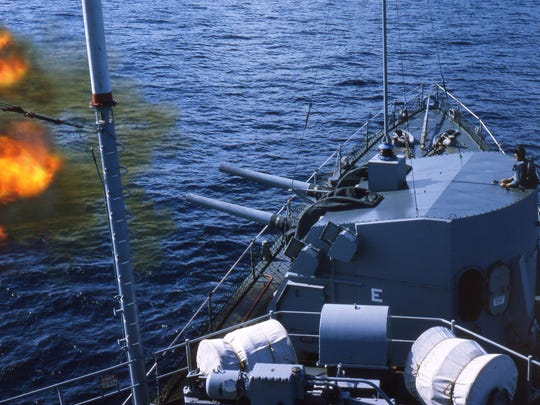
Gearing-class destroyer firing five-inch guns from forward mount.
(Photo: Courtesy of Bill Latta)
Division records also clearly note that the USS Craig was ordered to Da Nang Bay at max speed the night of 28 July to support Marines under attack. Its officers were told to contact a Marine spotter on a rarely used, specific radio frequency. Terminology used in these records banish any doubts that Division officers (specifically Maj. Gen. Walt) were acutely aware of the dire situation unfolding at the bridge, and that failure to defeat the 7th VC battalion there would have devastating impacts.
But what justified taking extreme measures to literally “disappear” a major engagement, the first significant U.S. battle of the Vietnam War, a battle that should be proudly recorded in Navy and Marine Corps histories? That question has motivated retired officers and enlisted personnel to search for answers. Many queried Pentagon contacts and petitioned archive offices.
This writer and other former military officers sent the original Steel Storm story and a letter to President Donald Trump, requesting his assistance in securing well-deserved decorations for then-Corporal Lippard and the USS Craig and USS Stoddard crews. A typical response—on White House stationery—assured that “your correspondence [has been] forwarded to the appropriate federal agency for further action.”
Three months later, a letter from J. E. Nierle, president of the Navy Department Board of Decorations and Medals, asserted that “we are currently gathering information,” and conducting “a review of Mr. Lippard’s service record.”
Another seven months passed, before similar rejection letters were sent to all petitioners. Speaking for the Navy board president, Mr. B. Hennen expressed regret that “no action can be taken on your request,” because bureaucrats could find “no evidence to suggest Mr. Lippard has ever been nominated for a personal decoration” related to combat actions at the Ca De River bridge. Because decades have passed, a nomination now must be “submitted by an officer with standing via a Member of Congress.” An enclosed pamphlet detailed stringent requirements, such as:
- A nominating officer must have been in Karl Lippard’s “chain of command, or had firsthand knowledge of the heroic act, or meritorious service…”
- And that officer “was senior to [Lippard] in either grade or position at the time of the act.”
Originators of a recommendation package “bear the burden of conducting all necessary research to gather supporting evidence,” such as obtaining eyewitness statements and endorsements by Lippard’s commanding officer and “all other surviving members of the original chain of command.”
After more than half a century, only one such officer is known to be alive, and absolutely no American “eyewitnesses” ever existed, because Karl Lippard was the sole U.S. combatant engaged in the fight ashore. Technically, crews of both ships were eyewitnesses, but the night was pitch dark and it was raining. None of the crewmembers laid eyes on the Marine spotter directing their fire. In short, precise requirements dictated by today’s Washington desk jockeys are impossible to satisfy.
Meanwhile, Karl Lippard was diligently trying to obtain a relatively low-level—yet treasured—Combat Action Ribbon (CAR) for the USS Craig and USS Stoddard. He assembled and delivered several packages of supporting data and records, but these were returned intact. One wonders whether they were ever opened, let alone reviewed.
Lippard also received several letters from B. Hennen, Executive Secretary of the Navy Board of Decorations and Medals, assuring that its staff had “reviewed all pertinent official records available…. Unfortunately, the evidence does not substantiate an award of the CAR to either ship.”
Incredibly, Hennen claimed that official “records related to the actions of USS JOHN R. CRAIG or USS STODDARD on July 28-29 1965, indicate those ships were part of pre-planned naval gunfire support missions, and that neither vessel was under enemy fire. …We must presume the Navy had access to the official operations reports of the incident, and based on those, determined the ships did not meet the CAR criteria.”
Absolutely false. The USS Craig was dispatched to the Ca De River bridge area by Maj. Gen. Walt in response to Karl Lippard’s “Mayday” plea. The ship pulled anchor and sailed immediately, leaving the ship’s captain ashore. The Stoddard appeared several hours later, jumped into the violent battle and helped the Craig obliterate the 7th VC, which was desperately attempting to capture the bridge. The claim that this was a “pre-planned naval gunfire support mission” or minor exercise—what Lippard calls “sky busting”—is laughable.
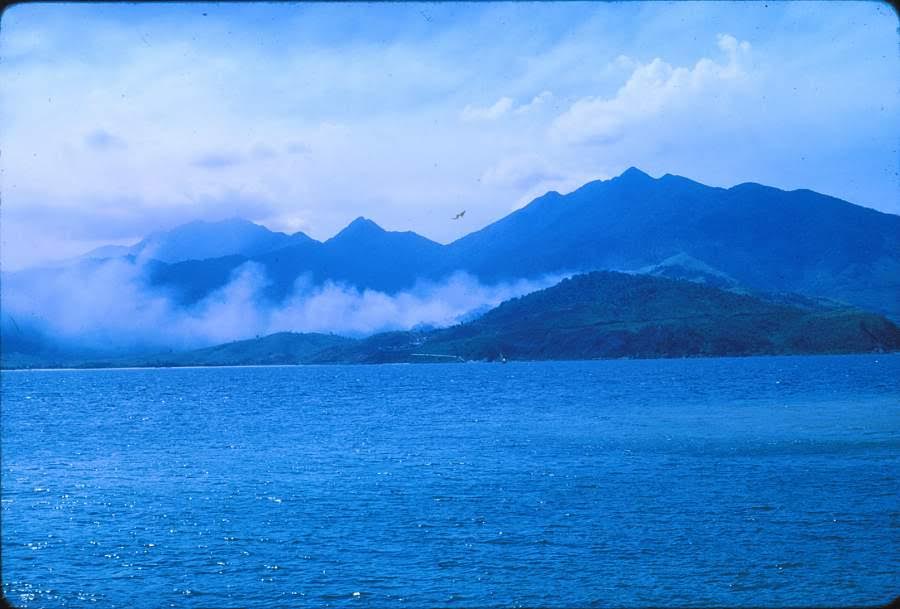
Photo taken from the USS Craig after exiting Da Nang Bay in the early morning of 29 July 1965 shows smoke over the battlefield pounded by 443 five-inch rounds. An Esso oil storage complex barely visible in the center was blown up by Viet Cong sappers on 5 August, a week after the Ca De River Bridge battle.
(Photo courtesy of Navy EM3 Hank Lehtola)
Further, both ships’ crews recall small arms rounds hitting their vessels, fired by enemy soldiers locked in a desperate battle with Lippard, South Vietnamese Ranger Sgt. Thi and two destroyers delivering death in a violent storm of five-inch shells. When a Viet Cong mortar round exploded in the water between Lippard (on the shore) and the ships, both firing all their five-inch guns broadside, the Stoddard shifted to a position farther from the beach. There’s no question that both vessels were under enemy fire. So, why were records altered to eliminate that factoid?
Finally, this writer’s research yielded what may be the overriding reasons for intentionally covering up the ferocious Ca De River bridge fight that destroyed an entire enemy battalion: Protecting the president and keeping China out of the war. In his bestselling book, Dereliction of Duty, H.R. McMaster reports that, on July 28, 1965, President Lyndon B. Johnson “left the Pentagon for the news conference…. Just after 12:30 [p.m.], when the television audience would be the smallest, [LBJ] walked into the East Room of the White House” to give reporters an update on troop buildups in Vietnam. During that briefing, “…Johnson again denied that forces deployed to Vietnam were already engaged in combat operations” (pp. 321-322).
Karl Lippard’s heroic defense of the Ca De River bridge, backed by two destroyers, occurred on that same date, 28 July 1965. Given that Vietnam is on the other side of the International Date Line, the engagement may have already occurred. Whether Johnson knew about the massive shootout is unclear. Nevertheless, his aides and every military officer between Corporal Lippard and the White House weren’t about to suggest the president had either lied or “misspoke.” To avoid White House embarrassment, the battle would simply have to disappear—be erased from history, as if it had never happened.
Senior Navy and Marine Corps officers evidently chose to not report that a solitary Marine Raider had called in more than 400 rounds of Navy five-inch rounds to annihilate a 600-man unit of Viet Cong and Chinese regulars, thereby proving the commander-in-chief had misled the American people. Although historians now agree that LBJ and his Secretary of Defense, Robert McNamara, routinely lied to U.S. citizens, today’s Deep State bureaucrats may still be protecting a favored president’s legacy to preclude yet another blemish.
That said, senior players in the chain-of-command may have had legitimate concerns that they thought warranted burying this historic battle. The president and Defense chief McNamara lived in constant fear that Communist China would jump into the Vietnam War, threatening a Korean War redux or igniting World War III. If the news media exposed the fact that Chinese soldiers were fighting alongside Viet Cong and North Vietnamese troops, and roughly 300 uniformed regulars had died at the hands of U.S. Marine and Navy forces, might China feel compelled to respond?
Obviously, China’s generals knew the People’s Liberation Army had lost hundreds of its crack troops at the Ca De River bridge. But unless America or China openly acknowledged that fact, both sides could pretend it never happened. Consequently, keeping the media and American people in the dark might have seemed the best political solution.
The fear-of-China theory is underscored by another strange “operation” that took place shortly after the Ca De River bridge shootout. A Navy explosive ordnance disposal (EOD) team supposedly was dispatched to the precise area bombarded by the Craig and Stoddard in response to Karl Lippard’s directives. Ostensibly, the team’s mission was to “disable unexploded ordnance.” Conflicting records indicate it either made a quick in-and-out excursion, or spent an unusual amount of time scouring that hellish killing ground. Did a team of EOD specialists remove every scrap of paper, insignia, clothing and personal items that could prove hundreds of Chinese soldiers had died there?
Reliable records of such a team’s activities in that area have yet to surface—if they exist at all. In fact, Lippard tracked down the first EOD specialist deployed to Vietnam. Mr. EOD confirmed that he never set foot in-country until late 1965, months after the Ca De River battle. If not an EOD team, then who cleaned up the battlefield? On whose orders?
A half-century has passed, since Karl Lippard survived that horrific battle north of the Ca De River bridge. Despite his yeoman efforts, the two ships that answered his call probably will never receive a Combat Action Ribbon for their unquestioned support of a Marine in dire straits. And, unless President Donald Trump personally sees fit to honor him, Karl Lippard will never receive well-deserved awards for his heroism under enemy fire.
As he’s stated time and again, Karl is less concerned with personal decorations than he is about ensuring the bravery and professionalism exhibited by Craig and Stoddard crews are recognized. How those men performed in the Ca De River bridge battle is a testament to the long tradition of sailors supporting Marines under attack, delivering immediate, accurate, withering fire from offshore. Nevertheless, Navy Department Board of Decorations and Medals bureaucrats have deemed the matter closed. In short, they firmly ordered, “Don’t bother us again.”
Perhaps records of that ferocious fight on 28-29 July 1965 were altered, redacted and “disappeared” to protect a president and assuage worries about China’s potential response. But President Johnson and China’s hard-nosed leaders of the 1960s are long gone.
Six decades later, it’s time to correct manipulated, distorted records and honor the warriors who saved America’s vaunted Marine Corps from a devastating defeat in mid-1965. Had the 7th VC battalion batted aside Lippard and a small cadre of Marines guarding the Ca De River bridge, the Vietnam War would have unfolded much differently. Exactly how will be left for true historians to speculate.
Lippard may not care about personal commendations, but the President of the United States, Secretary of the Navy, Commandant of the Marine Corps, and Chief of Naval Operations damn sure should. If future generations of Marines and sailors aren’t taught their hallowed history, salted with stories of uncommon valor and performance of duty under fire, how will they learn and truly understand the meaning of “Honor”?
America must acknowledge and honor the unselfish actions of its warriors. It’s the solemn duty of a grateful nation. If America fails to recognize and tangibly express appreciation for sacrifices made by her warriors—the men and women who fought and lived or died for their country—will future generations answer their nation’s call to give their lives in the name of liberty? Maybe not.
“The willingness with which our
young people are likely to serve in
any war, no matter how justified,
shall be directly proportional to how
they perceive the veterans of earlier
wars were treated and appreciated by their nation.”
George Washington
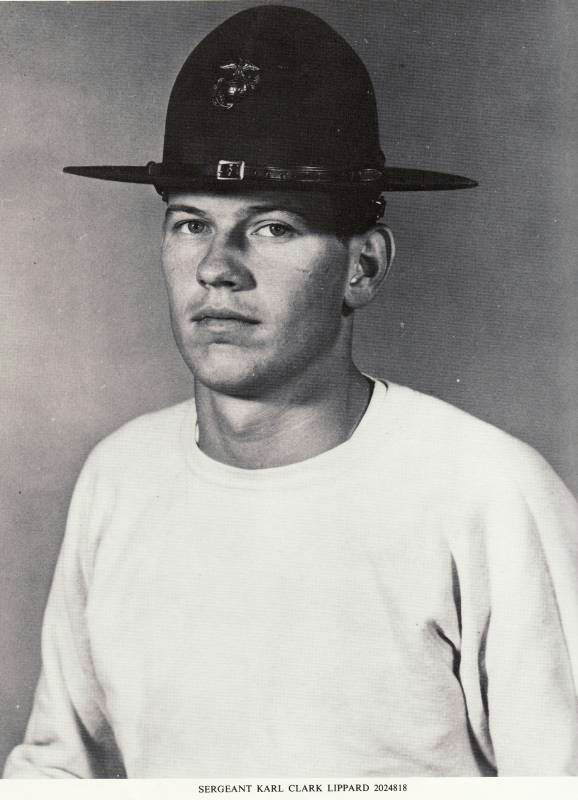
Sergeant Karl Lippard as a drill instructor at Marine Corps Recruit Depot
San Diego, CA
* Based on the few official records available, and the memories of those involved in the Ca De River bridge engagement of 28-29 July 1965. All photos and graphics courtesy of Karl Lippard.

